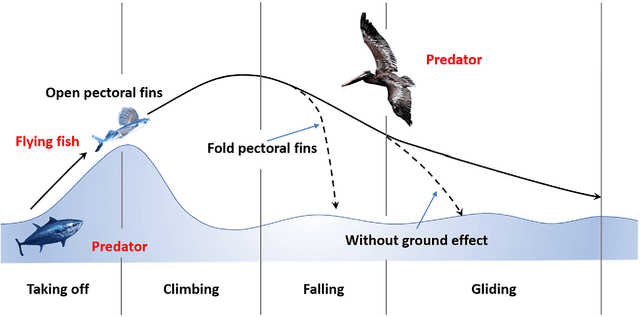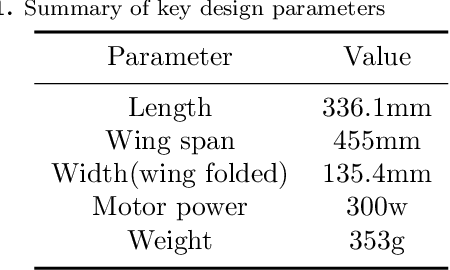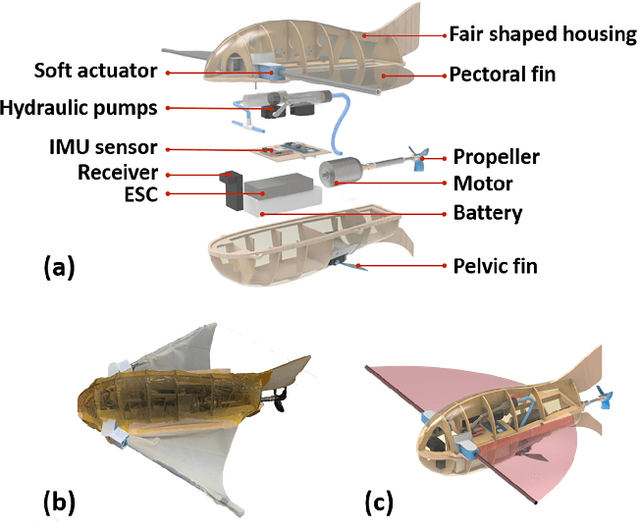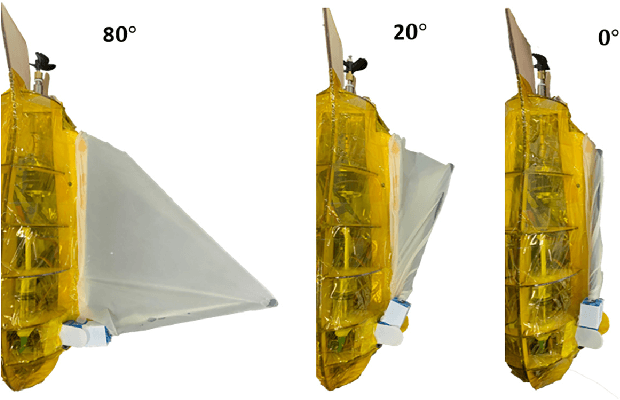Kangyao Huang
A General Infrastructure and Workflow for Quadrotor Deep Reinforcement Learning and Reality Deployment
Apr 21, 2025Abstract:Deploying robot learning methods to a quadrotor in unstructured outdoor environments is an exciting task. Quadrotors operating in real-world environments by learning-based methods encounter several challenges: a large amount of simulator generated data required for training, strict demands for real-time processing onboard, and the sim-to-real gap caused by dynamic and noisy conditions. Current works have made a great breakthrough in applying learning-based methods to end-to-end control of quadrotors, but rarely mention the infrastructure system training from scratch and deploying to reality, which makes it difficult to reproduce methods and applications. To bridge this gap, we propose a platform that enables the seamless transfer of end-to-end deep reinforcement learning (DRL) policies. We integrate the training environment, flight dynamics control, DRL algorithms, the MAVROS middleware stack, and hardware into a comprehensive workflow and architecture that enables quadrotors' policies to be trained from scratch to real-world deployment in several minutes. Our platform provides rich types of environments including hovering, dynamic obstacle avoidance, trajectory tracking, balloon hitting, and planning in unknown environments, as a physical experiment benchmark. Through extensive empirical validation, we demonstrate the efficiency of proposed sim-to-real platform, and robust outdoor flight performance under real-world perturbations. Details can be found from our website https://emnavi.tech/AirGym/.
Learning a Distributed Hierarchical Locomotion Controller for Embodied Cooperation
Jul 09, 2024Abstract:In this work, we propose a distributed hierarchical locomotion control strategy for whole-body cooperation and demonstrate the potential for migration into large numbers of agents. Our method utilizes a hierarchical structure to break down complex tasks into smaller, manageable sub-tasks. By incorporating spatiotemporal continuity features, we establish the sequential logic necessary for causal inference and cooperative behaviour in sequential tasks, thereby facilitating efficient and coordinated control strategies. Through training within this framework, we demonstrate enhanced adaptability and cooperation, leading to superior performance in task completion compared to the original methods. Moreover, we construct a set of environments as the benchmark for embodied cooperation.
CompetEvo: Towards Morphological Evolution from Competition
May 28, 2024



Abstract:Training an agent to adapt to specific tasks through co-optimization of morphology and control has widely attracted attention. However, whether there exists an optimal configuration and tactics for agents in a multiagent competition scenario is still an issue that is challenging to definitively conclude. In this context, we propose competitive evolution (CompetEvo), which co-evolves agents' designs and tactics in confrontation. We build arenas consisting of three animals and their evolved derivatives, placing agents with different morphologies in direct competition with each other. The results reveal that our method enables agents to evolve a more suitable design and strategy for fighting compared to fixed-morph agents, allowing them to obtain advantages in combat scenarios. Moreover, we demonstrate the amazing and impressive behaviors that emerge when confrontations are conducted under asymmetrical morphs.
Stimulate the Potential of Robots via Competition
Mar 15, 2024



Abstract:It is common for us to feel pressure in a competition environment, which arises from the desire to obtain success comparing with other individuals or opponents. Although we might get anxious under the pressure, it could also be a drive for us to stimulate our potentials to the best in order to keep up with others. Inspired by this, we propose a competitive learning framework which is able to help individual robot to acquire knowledge from the competition, fully stimulating its dynamics potential in the race. Specifically, the competition information among competitors is introduced as the additional auxiliary signal to learn advantaged actions. We further build a Multiagent-Race environment, and extensive experiments are conducted, demonstrating that robots trained in competitive environments outperform ones that are trained with SoTA algorithms in single robot environment.
6-DOF All-Terrain Cyclocopter
Sep 24, 2023

Abstract:This paper presents the design of a 6-DOF all-terrain micro aerial vehicle and two control strategies for multimodal flight, which are experimentally validated. The micro aerial vehicle is propelled by four motors and controlled by a single servo for the control of the cycloidal rotors(cyclorotors) speed and lift direction. Despite the addition of the servo, the system remains underactuated. To address the traditional underactuation problem of cycloidal rotor aircraft, we increase the number of control variables. We propose a PID and a nonlinear model predictive control (NMPC) framework to tackle the model's nonlinearities and achieve control of attitude, position, and their derivatives.Experimental results demonstrate the effectiveness of the proposed multimodal control strategy for 6-DOF all-terrain micro aerial vehicles. The vehicle can operate in aerial, terrestrial, and aquatic modes and can adapt to different terrains and environmental conditions. Our approach enhances the vehicle's performance in each mode of operation, and the results show the advantages of the proposed strategy compared to other control strategies.
Path Planning for Air-Ground Robot Considering Modal Switching Point Optimization
May 14, 2023



Abstract:An innovative sort of mobility platform that can both drive and fly is the air-ground robot. The need for an agile flight cannot be satisfied by traditional path planning techniques for air-ground robots. Prior studies had mostly focused on improving the energy efficiency of paths, seldom taking the seeking speed and optimizing take-off and landing places into account. A robot for the field application environment was proposed, and a lightweight global spatial planning technique for the robot based on the graph-search algorithm taking mode switching point optimization into account, with an emphasis on energy efficiency, searching speed, and the viability of real deployment. The fundamental concept is to lower the computational burden by employing an interchangeable search approach that combines planar and spatial search. Furthermore, to safeguard the health of the power battery and the integrity of the mission execution, a trap escape approach was also provided. Simulations are run to test the effectiveness of the suggested model based on the field DEM map. The simulation results show that our technology is capable of producing finished, plausible 3D paths with a high degree of believability. Additionally, the mode-switching point optimization method efficiently identifies additional acceptable places for mode switching, and the improved paths use less time and energy.
Bionic Collapsible Wings in Aquatic-aerial Robot
Apr 09, 2023



Abstract:The concept of aerial-aquatic robots has emerged as an innovative solution that can operate both in the air and underwater. Previous research on the design of such robots has been mainly focused on mature technologies such as fixed-wing and multi-rotor aircraft. Flying fish, a unique aerial-aquatic animal that can both swim in water and glide over the sea surface, has not been fully explored as a bionic robot model, especially regarding its motion patterns with the collapsible pectoral fins. To verify the contribution of the collapsible wings to the flying fish motion pattern, we have designed a novel bio-robot with collapsible wings inspired by the flying fish. The bionic prototype has been successfully designed and fabricated, incorporating collapsible wings with soft hydraulic actuators, an innovative application of soft actuators to a micro aquatic-aerial robot. We have analyzed and built a precise model of dynamics for control, and tested both the soft hydraulic actuators and detailed aerodynamic coefficients. To further verify the feasibility of collapsible wings, we conducted simulations in different situations such as discharge angles, the area of collapsible wings, and the advantages of using ground effect. The results confirm the control of the collapsible wings and demonstrate the unique multi-modal motion pattern between water and air. Overall, our research represents the study of the collapsible wings in aquatic-aerial robots and significant contributes to the development of aquatic-aerial robots. The using of the collapsible wings must a contribution to the future aquatic-aerial robot.
Coupled Modeling and Fusion Control for a Multi-modal Deformable Land-air Robot
Nov 09, 2022



Abstract:This paper introduces a structure-deformable land-air robot which possesses both excellent ground driving and flying ability, with smooth switching mechanism between two modes. The elaborate coupled dynamics model of the proposed robot is established, including rotors, chassis, especially the deformable structures. Furthermore, taking fusion locomotion and complex near-ground situations into consideration, a model based controller is designed for landing and mode switching under various harsh conditions, in which we realise the cooperation between fused two motion modes. The entire system is implemented in ADAMS/Simulink simulation and in practical. We conduct experiments under various complex scenarios. The results show our robot can accomplish land-air switching swiftly and smoothly, and the designed controller can effectively improve the landing flexibility and reliability.
A Multi-modal Deformable Land-air Robot for Complex Environments
Nov 01, 2022



Abstract:Single locomotion robots often struggle to adapt in highly variable or uncertain environments, especially in emergencies. In this paper, a multi-modal deformable robot is introduced that can both fly and drive. Compatibility issues with multi-modal locomotive fusion for this hybrid land-air robot are solved using proposed design conceptions, including power settings, energy selection, and designs of deformable structure. The robot can also automatically transform between land and air modes during 3D planning and tracking. Meanwhile, we proposed a algorithms for evaluation the performance of land-air robots. A series of comparisons and experiments were conducted to demonstrate the robustness and reliability of the proposed structure in complex field environments.
Intelligent Amphibious Ground-Aerial Vehicles: State of the Art Technology for Future Transportation
Jul 23, 2022



Abstract:Amphibious ground-aerial vehicles fuse flying and driving modes to enable more flexible air-land mobility and have received growing attention recently. By analyzing the existing amphibious vehicles, we highlight the autonomous fly-driving functionality for the effective uses of amphibious vehicles in complex three-dimensional urban transportation systems. We review and summarize the key enabling technologies for intelligent flying-driving in existing amphibious vehicle designs, identify major technological barriers and propose potential solutions for future research and innovation. This paper aims to serve as a guide for research and development of intelligent amphibious vehicles for urban transportation toward the future.
 Add to Chrome
Add to Chrome Add to Firefox
Add to Firefox Add to Edge
Add to Edge